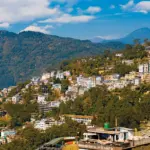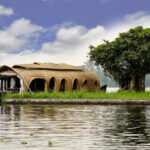Angkor Wat, designated as a UNESCO World Heritage Site and the world’s largest religious structure, has much more to offer. The beauty and architectural marvels it showcases are beyond words. In this blog, I will be discussing one of the iconic places and a paradise for history enthusiasts – Angkor Wat. It represents the pinnacle of Khmer architecture
Location

The Angkor Wat archaeological complex is situated approximately 5 km (3 miles) from Siem Reap, and reaching it on foot, while possible, is not recommended due to the long distances and Cambodia’s hot and dusty climate. Instead, you can consider renting a bicycle, although this is advisable mainly for avid cyclists, or hiring a tuk-tuk driver.
Tuk-tuks are the preferred mode of transportation for exploring the Angkor temples and can be easily found in Siem Reap, with a typical daily cost of around 20-30 USD. Read on to discover how to secure a reliable tuk-tuk driver.
Within the Angkor Wat complex, there are approximately 50 temples, but not all of them need to be visited as some are in varying conditions and share similar designs. To make the most of your visit, I recommend focusing on the must-see temples when exploring Angkor Wat.
Naturally, the primary attraction is the main temple within Angkor Wat itself. The city of Angkor once served as the royal center for a dynasty of Khmer kings, presiding over one of Southeast Asia’s most extensive, prosperous, and culturally advanced kingdoms. This period, spanning from the late 9th century to the early 13th century, saw numerous construction projects, with Angkor Wat being the most remarkable among them. Commissioned by Suryavarman II, this grand funerary temple was designed to house his remains. The construction process is estimated to have taken approximately three decades.
Built in the 12th century and unveiled to the world in 1860, Angkor Wat stands as the largest religious structure on the planet. It represents the very essence of Cambodia and is perhaps one of the most iconic landmarks in all of Asia.
Angkor Thom, the second most renowned attraction within the complex, is not just another Khmer temple; it’s an entire city complete with sanctuaries, gates, terraces, streets, and more. It served as the last grand capital of the Khmer Empire and is a truly magnificent site.
Within Angkor Thom, the most noteworthy spot is the central city temple, Bayon. This temple is adorned with 54 enormous smiling faces and is an enchanting destination that captivates visitors from around the world.
Moving on to Ta Prohm, often referred to as the ‘Tomb Raider Temple’ due to its appearance in the Angelina Jolie movie. However, the true magic of Ta Prohm lies beyond the movie’s fame. Abandoned around the 15th century, the jungle swiftly reclaimed the temple, with Silk-cotton and Strangler fig trees taking root amidst the ruins, creating a breathtaking fusion of nature and architecture.
Preah Khan, a sprawling temple that once housed a population of 100,000, is one of the complex’s most underestimated gems. It’s a must-visit when exploring Angkor Wat, and you’d be wise not to skip it. The temple is divided into four enclosures, each adorned with stunning bas-relief carvings. Access to Preah Khan involves crossing one of the famous moat bridges featuring depictions of a battle between mythical Garudas and the King of Nagas.
The ‘Citadel of Chambers’ stands as another hidden treasure within Angkor Wat. This labyrinth is rich in bas-relief carvings portraying mythical creatures and legends. Unlike the other temples, it’s not on the main tourist route, so you can enjoy this sanctuary without battling crowds.
How to reach Angkor wat?

Angkor Wat is located in Siem Reap, Cambodia. You can reach it by:
Fly: Most international travellers fly into Siem Reap International Airport (REP). From there, it’s a short drive to Angkor Wat.
Bus: There are long-distance bus services from various cities in Cambodia and neighbouring countries to Siem Reap.
Boat: During the wet season, you can reach Siem Reap via boat along the Tonlé Sap Lake.
Tuk-Tuk or Taxi: Once in Siem Reap, you can hire a tuk-tuk or taxi to take you to Angkor Wat, which is just a few kilometres north of the city.
Bicycle: Many travellers choose to rent bicycles to explore the temples at their own pace.
Visiting Angkor Wat is not hard. Being one of the most popular tourist attractions in Asia and the biggest highlight of Cambodia, the ancient Khmer city hosts millions of tourists every year.
Visiting Angkor Wat the best way possible and having a wonderful time – well, this is not as easy as it sounds. Avoiding hordes of tourists, surviving Cambodia’s scorching heat, and finding the best route around the dozens of temples can leave you physically and emotionally exhausted. Visiting Angkor really is a daunting task.
Some special tips
Sunrise Viewing: Arrive early to catch the stunning sunrise over Angkor Wat. It’s a popular and magical moment, so be prepared for crowds.
Dress Code: Angkor Wat is a sacred site. Wear modest clothing that covers your shoulders and knees to show respect.
Tickets: Purchase your tickets at the official Angkor Archaeological Park ticket centre. Check the current ticket prices and validity periods.
Map and Guide: Get a map and consider hiring a local guide who can provide historical context and take you to less crowded spots.
Hydration and Sun Protection: Bring water, sunscreen, and a hat to protect yourself from the sun, as it can get very hot.
Footwear: Comfortable, sturdy shoes are essential, as you’ll be walking and climbing.
Timing: Visit popular temples like Angkor Wat and Ta Prohm early or late in the day to avoid crowds.
Explore Beyond Angkor Wat: Angkor Thom, Bayon, Ta Prohm, and Banteay Srei are just a few of the many fascinating temples in the area.
Respect the Temples: Do not touch carvings or climb on structures. Follow guidelines and respect the site’s historical significance.
Stay Hydrated: The climate can be hot and humid. Carry water with you to stay hydrated.
Local Cuisine: Try Cambodian food at local restaurants outside the temple complex for a taste of the local culture.
Insect Repellent: Bring insect repellent to protect yourself from mosquitoes, especially during the wet season.
Patience: Be patient with the crowds and consider visiting less-visited temples for a more tranquil experience.
Conservation: Support responsible tourism by not purchasing from vendors selling items made from stolen artefacts.
Wildlife: Be cautious of wildlife, such as monkeys, which can be mischievous and may snatch food or belongings.
Enjoy your visit to Angkor Wat! It’s a remarkable archaeological site with a rich history and incredible architecture.
Where to stay?
You can find a large number of accomodation options near Siem Reap town .You can book them according to your budget and preferences.
Final thoughts
A place that is an amalgamation of nature and historical temples. Its beauty categorically speaks of its rich history. If you are a history buff, then this is a place that will provide you with an enchanting experience.











